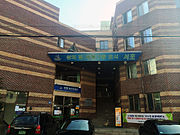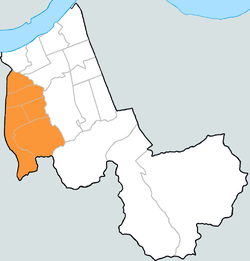
Back بانگبا-دونگ Persian 방배동 Korean Bangbae-dong Malay Bangbae-dong SCO Bangbae-dong Swedish Bangbae-dong Vietnamese 方背洞 Chinese
Bangbae-dong | |
|---|---|
| Korean transcription(s) | |
| • Hangul | 방배동 |
| • Hanja | 方背洞 |
| • Revised Romanization | Bangbae-dong |
| • McCune–Reischauer | Pangbae-dong |
 Bangbae 1-dong Community Service Centre | |
 Bangbae-dong within Seocho District | |
| Country | South Korea |
| Area | |
| • Total | 6.64 km2 (2.56 sq mi) |
| Population (2012) | |
| • Total | 120,020 |
| • Density | 18,000/km2 (47,000/sq mi) |
Bangbae-dong (Korean: 방배동) is a dong (neighborhood) of the greater Gangnam area Seocho District of the South Korean city of Seoul.[1] Bangbae-dong is divided into 5 different dongs which are Bangbaebon-dong, Bangbae 1-dong, 2-dong, 3-dong and 4-dong. The origin of Bangbae-dong is derived from the name Bangbae, meaning "dong-ri with my back to Mt. Myeon-ri," which rises on the border between Gwanak District and Seocho District. Bangbae-dong was Bangbae-ri, Sangbuk-myeon, Gwacheon-gun, Gyeonggi-do until the end of the Joseon Dynasty, but became Bangbae-ri, Sindong-myeon, Siheung-gun, Gyeonggi-do in 1914 when the area was confirmed during the Japanese colonial period. It was incorporated into the Seoul Metropolitan Government following the expansion of the Seoul Metropolitan Government's zone in 1963, and became Bangbae-dong to this day. The location is Dong at the western end of Seocho District, and it is an area from the intersection of the road from Seoul to Gwacheon and the southern circulation road to Umyeon Mountain.
- ^ 방배동 (Bangbae-dong 方背洞) (in Korean). Doosan Encyclopedia. Retrieved 2008-04-16.[permanent dead link]